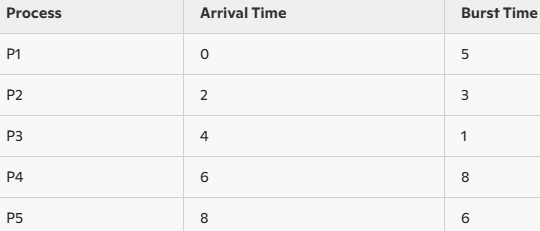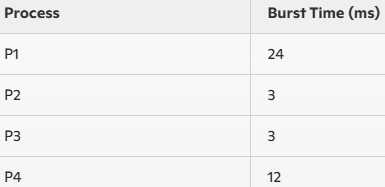Correct option is D
Let’s solve it.
1. Calculate Completion Time for Each Process:
· P1: Completes at 0+5=50 + 5 = 5
· P2: Completes at 5+3=85 + 3 = 8
· P3: Completes at 8+1=98 + 1 = 9
· P4: Completes at 9+8=179 + 8 = 17
· P5: Completes at 17+6=2317 + 6 = 23
2. Calculate Turnaround Time (TAT) for Each Process:
· TAT = Completion Time - Arrival Time
· P1: 5−0=55 - 0 = 5
· P2: 8−2=68 - 2 = 6
· P3: 9−4=59 - 4 = 5
· P4: 17−6=1117 - 6 = 11
· P5: 23−8=1523 - 8 = 15
3. Calculate Waiting Time (WT) for Each Process:
· WT = Turnaround Time - Burst Time
· P1: 5−5=05 - 5 = 0
· P2: 6−3=36 - 3 = 3
· P3: 5−1=45 - 1 = 4
· P4: 11−8=311 - 8 = 3
· P5: 15−6=915 - 6 = 9
4. Calculate Average Waiting Time (AWT):

5. Calculate Average Turnaround Time (ATAT):

Correct Answer: (d) Average Waiting Time: 3.8, Average Turnaround Time: 8.4
Important Key Points:
1. FCFS Scheduling: In FCFS, processes are executed in the order they arrive.
2. Completion Time: The time at which a process finishes its execution.
3. Turnaround Time: Total time taken from arrival to completion.
4. Waiting Time: Time a process spends waiting in the ready queue.
Knowledge Booster:
1. Job Scheduling Algorithms: Different algorithms (FCFS, SJF, Round Robin, etc.) have different impacts on process execution and waiting times.
2. Performance Metrics: Average Waiting Time (AWT) and Average Turnaround Time (ATAT) are critical metrics to evaluate the efficiency of scheduling algorithms.
3. Context Switching: Understanding the overhead caused by context switching is essential for choosing the right scheduling algorithm.







 English
English 40 Questions
40 Questions 20 Mins
20 Mins
